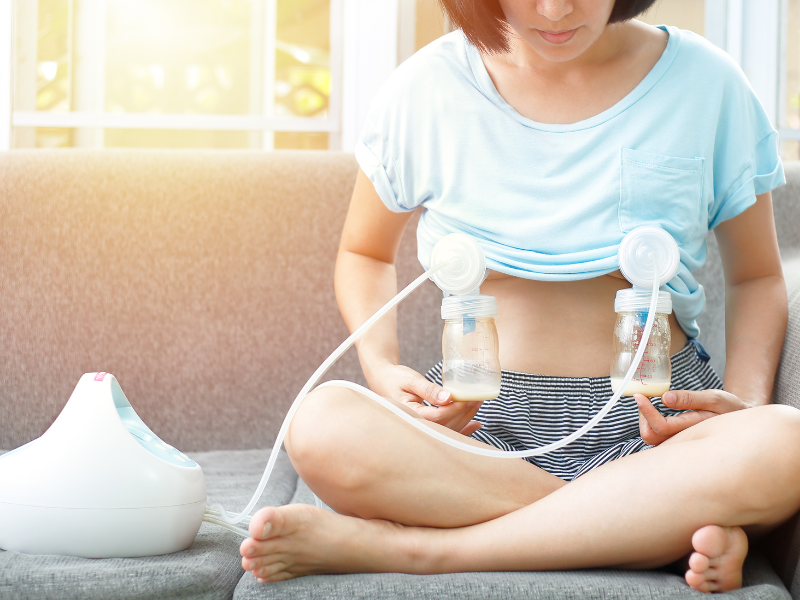One of the most talked-about techniques for increasing milk production is something called “power pumping.” It’s not a magic trick, but it can be a game changer when done right.
In this guide, we’ll break down what power pumping is, how it works, what results to expect, and how to do it safely and effectively.
What Is Power Pumping?
Power pumping (also called cluster pumping or super pumping) mimics the frequent, on-and-off nursing behavior of a baby going through a growth spurt. During these times, babies naturally feed more often to signal the body to make more milk. Power pumping follows that same logic. The idea is: the more often you remove milk, the more your body is triggered to make.
It’s typically done once a day for about an hour, using a specific pump/rest pattern to ramp up stimulation. It’s not a replacement for your regular nursing or pumping sessions—it’s an add-on to help boost supply.
Important! if your baby is able to breastfeed, prioritize that over pumping. Baby at the breast is still the most efficient milk remover.
The Science Behind Power Pumping
Your milk supply runs on a supply-and-demand system. Emptying the breasts frequently tells your body, “We need more milk.”
Power pumping gives your body a concentrated burst of demand. This extra stimulation boosts the release of prolactin, the key hormone that helps make more milk.
One small study showed a nearly 2x increase in output after just one week of daily power pumping sessions. That’s not guaranteed for everyone, but it shows the potential when the method is used consistently and correctly.
Who Should Try Power Pumping (and Who Shouldn’t)
Power pumping might be right for you if:
- You’ve noticed a drop in supply (from stress, illness, baby sleeping longer stretches, etc.)
- You’re exclusively pumping
- You’re building a stash before returning to work
- You’re managing latch issues
Skip power pumping if:
- Your supply is currently matching your baby’s needs
- You’ve experienced oversupply, clogged ducts, or mastitis
- You haven’t addressed possible underlying issues (like flange fit, hormone imbalances, or baby’s latch)
Not sure? Start by reading: “Is My Baby Getting Enough Milk While Breastfeeding?” Then consider checking in with a lactation consultant for personalized guidance.
How to Power Pump: Step-by-Step
Choose one hour a day—many moms find mornings work best, since milk supply is usually higher then. Ideally, do it right after a breastfeeding session (if applicable).
Double Pumping Schedule (Most Effective)
- Pump 20 minutes
- Rest 10 minutes
- Pump 10 minutes
- Rest 10 minutes
- Pump 10 minutes
Yes, even if milk stops flowing—keep going. This session is about stimulation, not just output.
Single Pump Schedule (Alternate Method)
- Pump 10 minutes on right
- 10 minutes on left
- 10 minutes on right
- 10 minutes on left
- 10 minutes on right
- 10 minutes on left
You might see results within 2–3 days. For others, it may take closer to a week. Some parents swear by a “Power Pumping Boot Camp”: 3–4 sessions per day over a weekend to kickstart supply.

Tips to Maximize Your Results
- Stay relaxed: Stress can block let-down. Try watching a show or listening to music.
- Use warm compresses before pumping or rinse pump parts under warm water.
- Massage your breasts while pumping—this is called hands-on pumping.
- Look at photos or videos of your baby to boost oxytocin and milk flow.
- Make power pumping manageable: Listen to music and time your session by songs—4 songs on, 2 songs off.
- Make yourself comfortable: Set up pillows, snacks, water. A cozy space helps.
- Use a hands-free pumping bra (store-bought or DIY).
- Use nipple cream post-session to prevent soreness.
- Don’t wash pump parts after every use—store them in the fridge and wash once daily.
- Stay hydrated: Water, herbal teas, or energy-boosters like “jungle juice” can help.
What’s a Normal Pumping Output?
Total pumping output varies, but here’s what’s typical:
- 0.5 to 2 ounces (15 – 60ml) per session is normal for a nursing parent.
- Many parents need to pump 2–3 times to gather enough milk for one feeding.
Don’t stress if you have a low-output session. Milk volume can vary hour to hour or day to day.
Your output may dip temporarily due to:
- Hormonal birth control
- Ovulation or menstruation
- Incomplete breast emptying
- Baby going through a growth spurt
The key? Keep removing milk frequently. An empty breast produces more milk.
After the Boost: Maintaining Your Supply
Once you’ve seen an increase:
- Return to your regular pumping/feeding schedule
- Consider power pumping once or twice a week as a top-off
- Watch for dips and reintroduce a power pumping session if needed
Final Thoughts
Power pumping can be time-consuming and, yes, tiring. But for many, it’s a gentle, non-invasive way to get milk production moving in the right direction. The trick is consistency, comfort, and staying tuned in to your body.
Remember: even if your results are gradual, any increase is still progress. Keep going. And when in doubt, get support—you don’t have to figure this out alone.
You’ve got this.

References
- “Power pumping is a technique that’s designed to mimic cluster feeding, and in turn, encourage your body to begin producing more breast milk.” Healthline
- Nest Collaborative (Oxytocin & Relaxation Tips)
- Breastfeeding Support (Warm Compress & Pumping Tips):
- Children’s Health (Visual Cues & Milk Flow)
- KellyMom (Hydration & Milk Supply)


